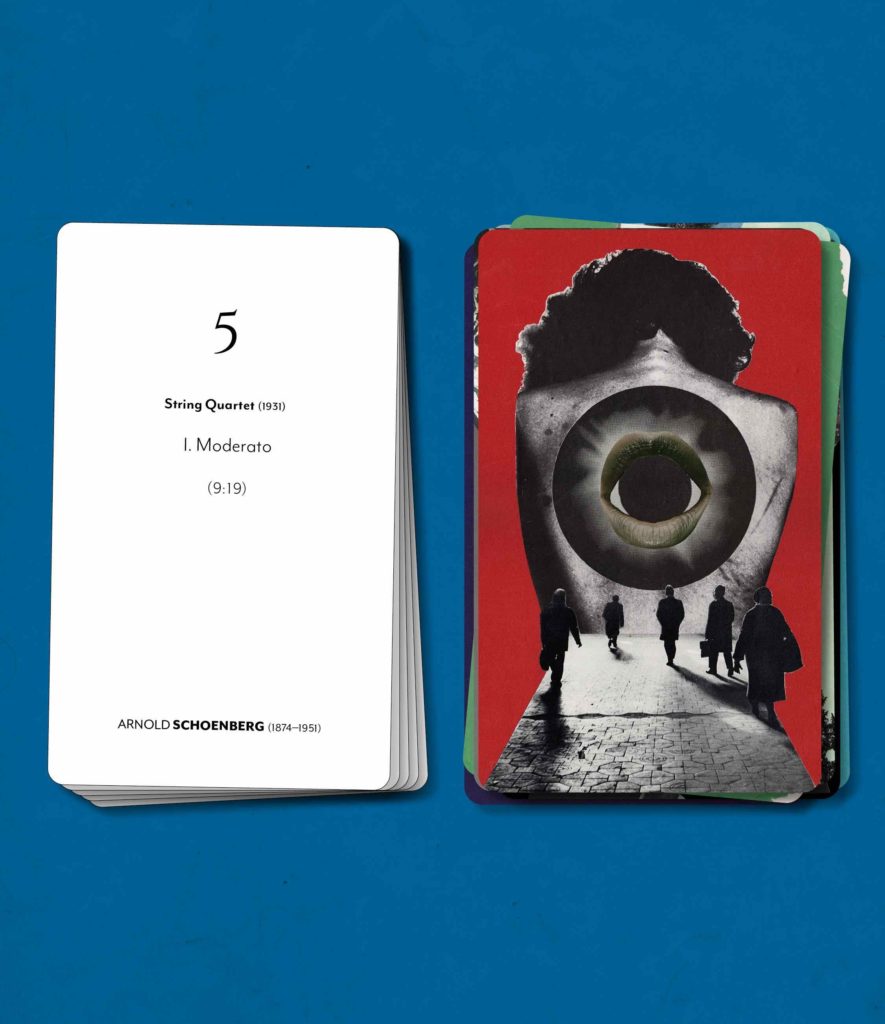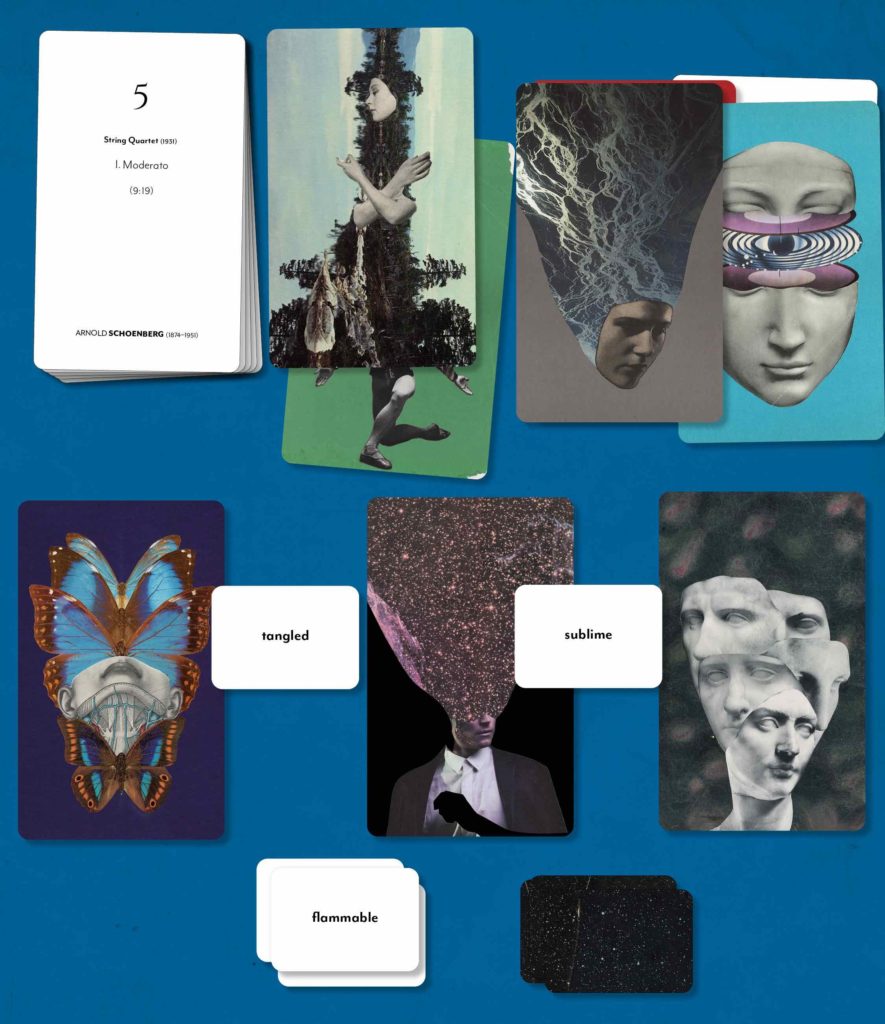Virtual Release
Spektral Quartet Touts New Listening Experience
This week Spektral Quartet, Chicago’s multi-grammy nominated ensemble, releases their fourth full length studio album: Experiments in Living. Taking its namesake from a quote by utilitarian philosopher John Stuart Mill the album is meant to be “an interactive, deep-listening excursion through Spektral’s expansive repertoire.” The conceptual cornerstone of this project is Spektral’s philosophy that pairing classic standards with new contributions can alter our perception of both.
This album, unlike most, is not meant to be listened to from start to finish. The music is paired with a collection of Tarot-style cards from Copenhagen-based artist øjeRum. These strikingly colored cards are meant to guide the listener through an aleatoric process. Spektral Quartet has devised a system wherein the album can last fifteen minutes, fifty minutes, or longer (depending on how you choose to draw your cards.) Featuring the work of seven composers and roughly two hours of audio this collection is a bold attempt to offer art music consumers a new experience in the age of streaming. The A side features the works of Brahms, Schoenberg, and Crawford (Seeger) while the B side showcases the newer talents of Sam Pluta, Anthony Cheung, Charmaine Lee, and George Lewis. In the following sections I will address each work separately before circling back to discuss the experience that the album offers.
Johannes Brahms: String Quartet in C minor, Op. 51 No. 1
The first four tracks on this album (if you were to listen chronologically) are composed of Brahms’ String Quartet #1 in C minor. This work serves as an interesting study in the personality and creative habits of the great German Composer. So infamously indecisive was Brahms that, to this day, composers remark that they have a case of “Brahms Syndrome” when they feel the need to continuously revise an otherwise completed project. Op. 51 is no exception. In typical Brahmsian style the creation of this work took place slowly over the course of eight painstaking years. There is evidence that he started writing this piece as early as 1869 and destroyed upwards of 20 different manuscripts on his way to finally publishing the work in the Summer of 1873 (at the age of 40). Brahms’ contribution to the Western canon cannot be overstated, but it certainly seems that if one were tasked with finding a composer to choose a restaurant with that Brahms might not be the wisest choice.
Brahms’ fickle nature is on full display in this recording. The first movement opens with a fast-paced, angsty, a full-bodied phrase which soon gives way to thin and impish recantation. These two, seemingly opposed, dispositions unceasingly oscillate throughout this movement with a mastery so refined that it makes Kanye seem emotionally stable in comparison. The second movement is careful and elegant. Brahms takes 7 and a half minutes to patiently walk the listener through a satisfying series of gentle motivic developments and perfectly curated counterpoint. The third movement is a wandering, almost improvisatory, exploration. It is ambiguous in character. Motion never ceases, but it never seems to have a precise destination. In the final movement Brahms reestablishes the confidence with which the first movement began, but this time he is less willing to recant. There are intermittent moments of intimacy, but they come few and far between as Brahms demonstrates exactly how he earned his moniker as the third “B” of classical music.
We tend to talk about Brahms as two separate people. On one hand we have the arbiter of Brahms syndrome. The sad sack who was chronically crippled by self-doubt. The man who, by all indications, erased far more music than he ever published. On the other hand we have the fiery German master. The heir apparent to the First Viennese School. The man who, although he most assuredly second guessed himself along the way, had the wherewithal to continue the legacy of the Symphony in a world void of Beethoven. And when told, at his favorite bar in Vienna, that his first symphony sounded like Beethoven’s 10th replied curtly, “Do you think you are the first jackass to tell me that?” Perhaps what makes Op. 51 No. 1 so compelling is that both dualities of Brahms are so prominently depicted in the music.
Arnold Schoenberg: String Quartet No. 3, Op. 30
54 years after the premier of the aforementioned Brahms, but in the same town, Arnold Schoenberg premiered his String Quartet no. 3. Nearly two decades had passed since Vienna had witnessed a work in this medium from the thorny and often temperamental composer. His String Quartet no. 2 had been remarkably unusual in that, in addition to a typical four players, it also called for a solo Soprano. Op. 30, however, carries a uniqueness of its own. Schoenberg had previously utilized his 12-tone system in a handful of solo works and chamber pieces, but this work marks the first use of this invention for string quartet. Schoenberg traded late stage romantic harmony and unconventional structure for the dodecaphonic system and a return to strict classical form. This addition to Schoenberg’s discography follows the typical four movement structure that we might see in Mozart, Beethoven, Schubert, or Brahms.
Movement one “Moderato” follows a par for the course sonata form. This first section, from start to finish, is unified with energetic pulsing eight notes and boasts soaring high violins. In regards to this movement Schoenberg had this to say: “As a little boy I was tormented by a picture of a scene of a fairytale “Das Gespensterschiff”, (The Ghostship) whose captain had been nailed through the head to the topmast by his rebellious crew. I am sure that this was not the program of the first movement of the third string quartet. But it might have been, subconsciously, a very gruesome premonition which caused me to write this work, because as often as I thought about this movement, that picture came to my mind.” With that comforting thought we will move on to following movements.
A Theme and Variations was chosen as the blueprint for the second movement. This decision was no doubt a tip of the hat to his city’s musical past. Next is the bouncing third movement, which hints towards a Viennese Waltz, and the finale comprised of a Sonata-Rondo. Schoenberg’s music seems tame and conservative to us today, but at its time it was the greatest musical experiment that had ever been conducted (sans Leonin and Perotin). The inclusion of this piece fits wonderfully into the spirit of the album.
Ruth Crawford (Seeger): String Quartet 1931
The final piece of this album’s A side is Ruth Crawford Seeger’s String Quartet 1931. In 1930 Ruth Crawford (as she was known at the time) was the first woman to receive a Guggenheim Fellowship. In private letters to her future husband she goes into detail on the origins of this work. For six months she had set her sights towards composing her first symphony, but this vision never manifested. Instead, she completed a handful of significant chamber pieces, one of which being, this seminal work of string quartet literature.
The often sparse and understated first movement demonstrates Crawford’s keen ability to develop phrases and thematic material in the absence of conventional harmony. The second, fast paced and furiou, features quick pass-offs and extended figures which descend seamlessly between voices. Seeger’s ability, through orchestration, to make for four players sound like one is possibly the most captivating aspect of this movement. The third movement, clocking in at just under four minutes, is the longest and perhaps most innovative. Two-thirds of this section is spent in a long and steady crescendo. Voices enter, diseapper, layer, and mingle as the music slowly boils over. Once the peak has been reached it quickly tapers off to end where it began. The final portion of this work is composed entirely of dialogue between the first violin and the rest of the ensemble. Seeger utilized shocking sonorities by writing the second violin, viola, and cello in unison motion and octaves throughout; and in doing so brazenly broke some of the most regarded rules of counterpoint. The speed and precision with which Spektral Quartet plays – the entire piece, but particularly – this final movement set it apart from previous recordings.
Sam Pluta: binary/momentary logics: flow state/joy state
Fellow Chicagoan composer Sam Pluta opens up the B side of this album. His piece, binary/momentary logics: flow state/joy state was commissioned by Spektral Quartet and premiCharaminered in June of 2016 at Constellation in Chicago. Pluta explained the work thusly, “This piece explores the joy of opening up the mind to improvisatory exploration. It is also an attempt at orchestrating for acoustic instruments with my electronic improvisational language.” Pluta paints with a diverse pallet of sound, texture, and timbre. He uses, what appears to be, virtually every technique that a string instrument can achieve – standard or extended – to great effect. Twenty-five separate, but continuous, movements take place in just under nine minutes. Some of the titles are as descriptive as “loose cannon”, “slide”, and “double duo” while others are as esoteric as “professor dr. squiggly, dma” and “universal consciousness”. The album’s overarching theme of experimentation is omnipresent in this piece which makes it a perfect and welcomed addition to the tracklist.
Anthony Cheung: The Real Book of Fake Tunes
Lovers of Jazz, or people who have paid large sums of money to have people talk at them about Jazz, will undoubtedly be familiar with “The Real Book”. It is a collection of lead sheets, for different instruments, containing Jazz standards. The idea is that the musician can quickly familiarize himself with a chart when it is called at a gig. This piece by Anthony Cheung pays satirical homage to the famous tome in five movements.
Cheung describes each movement as having a distinct character. The first as a “floating, weightless introduction that turns capricious,” the second as “a somewhat sorrowful ballad with interruptions,” the third as “a semi-serious scherzo that swells and subsides in wave-like motions,” the fourth as a “resonance study that turns into a free-flowing, improvisatory rhapsody,” and the finale as “the closest one gets to a “tune” in the familiar sense, with repeated and expanding yet irregularly timed chord progressions that might remind some of John Coltrane’s “Countdown.”
In these tracks Spektral is joined by Brooklyn-based flautist Clarie Chase. As stated, each movement of this piece has its own character, but the character revealed most is that of Anthony Cheung as a talented, inventive, and supremely original composer full of wit and charm.
Charmaine Lee: Spinals
From a style standpoint Charmaine Lee’s Spinals track is where this quartet delivers on its promise of experimentation the most. This piece was devised as a collaboration between Spektral and New York based vocalist and improviser Charmaine Lee. The piece is composed of an assortment of vocal sounds over noisy electronics and an ever-changing base of strings. As a fan of music – and new music in particular – I am not incredibly shocked when I listen to a piece like this. It is, however, shocking to hear it done so right. Spinals is an example of the latter. This piece offers what many in its genre do not; the sense that it was carefully constructed in some way. There are moments of extreme chaos, but also silence. There are peaks and valleys. Intensity and reprieve. Many pieces of this persuasion intentionally bombard you, but Spinals lures you in with a feeling of true sincerity. That one group can play Brahms as precisely as they do while convincingly playing this piece is a testament to the superior command of style possessed by the members of Spektral Quartet.
George Lewis: String Quartet 1.5: Experiments in Living
The final track of this album is the “title track” String Quartet 1.5: Experiments in Living by George Lewis. Lewis has a reputation as a creative renaissance man. He is well known for his contributions to computer music, his illustrious scholarly career, and his efforts as an installation artist. He is also objectively and unequivocally a Composer (with a capital C). The piece starts with a section of sultry harmonics, pointed plucks, and harsh rhythmic interjections. This is followed by an extended series of smooth glissandos and ambient lows. The third section, which begins near the halfway mark, is more rhythmic in nature. Pizzicatos play a supporting role throughout the piece, but are given their closeup here in a full ensemble section that sounds more like a kalimba than a string quartet. The fourth section is marked by extreme use of range for all parties. Swelteringly high violins soar as the cello delivers gutural tremolos. The finale is a series of chaotic pass off and blistering runs that showcase the ensemble’s virtuosity, Lewis’ compositional prowess, and his ability to build a sound structure.
The Experience
First and foremost I will say this: the album is performed, recorded, and produced beautifully. It delivers – and exceeds – the promise of quality that you would expect from a group of this caliber. The dazzling performances of Claire Chase (flute) and Charmaine Lee (composition, voice, and electronics) add variety and push this project beyond a “par for the course” String record. The music speaks for itself, but the selling point of the album is the interactive experience.
When I first downloaded the album and sorted through the promotional material I was torn. The angel on my right shoulder was saying that it was an interesting idea; that I should give it a chance. The devil on my left was saying the only innovative thing they’ve managed to achieve is complicating a handy little invention commonly referred to as “the shuffle feature”. The premise is that you can listen to this album in a different order each time. Instead of going through the tracks numerically you can skip around and choose your own adventure. That idea, in itself, is not at all novel. As a matter of fact, you can already do that with any album you choose. Blood on the Tracks is around fifty-two minutes long, but sometimes I just want to listen to “Tangled Up in Blue” and “Shelter from the Storm”. The question that I kept coming back to was this: how is that any different than creating a playlist on Spotify?
We are all so used to streaming our music. That ease of access is a catch 22. Any song we want is at the touch of our finger, but that ease sometimes makes us lose the reverence we should have. Igor Stravisnky said, “For one can listen without hearing, just as one can look without seeing. The absence of active effort and the liking acquired for this facility make for laziness.” He was talking about radio and the phonograph, but it is shocking how much more accurate this statement becomes when applied to streaming.
I used to buy CDs. I would spend every cent of my Christmas money at Best Buy as a teenager. There was a ritual to unboxing the disk, looking at the album art, reading the liner notes, and intently following along with the lyrics for the duration of the album. That ritual has been replaced – and I hate to admit it, but I feel that I am not alone here – with absently listening to one movement I like from a Mozart Symphony, two or three Drake songs, and half of a podcast episode; all while cleaning my house, eating dinner, scrolling on Instagram, and texting. That is what makes this album so remarkable. The act of receiving those Tarot cards in the mail, opening the box, reading about the album, picking the order of tracks. The experience forced me to take a minute and be actively involved.
Will this revolutionize how we consume art music in the 21st century? No, probably not. Is it meant to? I don’t think so. I think it was meant to be an experiment, but it is an experiment with value that we should all take a part in. The experience is a truly beautiful thing. The album will be released on August 28, 2020. You can find more information on their website: https://spektralquartet.com/experiments-in-living
✌️ Comment Below!




